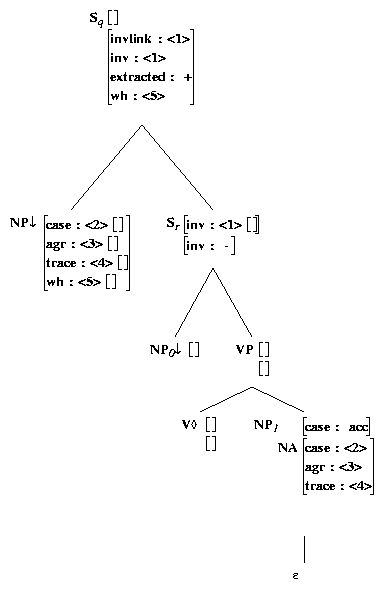



Next: Topicalization and the value
Up: Sentence Types
Previous: Passives
Extraction
The discussion in this chapter covers constructions that are analyzed
as having wh-movement in GB, in particular, wh-questions and
topicalization. Relative clauses, which could also be considered
extractions, are discussed in Chapter 15.
Extraction involves a constituent appearing in a linear position to the left of
the clause with which it is interpreted. One clause argument position is
empty. For example, the position filled by frisbee in the declarative in
sentence ((183)) is empty in sentence ((184)). The wh-item what in
sentence ((184)) is of the same syntactic category as frisbee in
sentence ((183)) and fills the same role with respect to the
subcategorization.
(182)0(182
- (183)
- Clove caught a frisbee.
(183)0(183
- (184)
- Whati did Clove catch
?
The English XTAG grammar represents the connection between the extracted
element and the empty position with co-indexing (as does GB). The <trace> feature is used to implement the co-indexing. In extraction trees
in XTAG, the `empty' position is filled with an .
The
extracted item always appears in these trees as a sister to the Sr
tree, with both dominated by a Sq root node. The Sr subtrees in
extraction trees have the same structure as the declarative tree in the same
tree family. The additional structure in extraction trees of the Sq and
NP nodes roughly corresponds to the CP and Spec of CP positions in GB.
All sentential trees with extracted components (this does not include relative
clause trees) are marked <extracted>=+ at the top S node, while
sentential trees with no extracted components are marked <extracted>=-. Items that take embedded sentences, such as nouns, verbs
and some prepositions can place restrictions on whether the embedded sentence
is allowed to be extracted or not. For instance, sentential subjects and
sentential complements of nouns and prepositions are not allowed to be
extracted, while certain verbs may allow extracted sentential complements and
others may not (e.g. sentences ((185))-((188))).
(184)0(184
- (185)
- The jury wondered [who killed Nicole].
(185)0(185
- (186)
- The jury wondered [who Simpson killed].
(186)0(186
- (187)
- The jury thought [Simpson killed Nicole].
(187)0(187
- (188)
- The jury thought [who did Simpson kill]?
The <extracted> feature is also used to block embedded topicalization
in infinitival complement clauses as exemplified in ((189)).
(188)0(188
- (189)
- * John wants [ Billi [PRO to see ti]]
Verbs such as want that take non-wh infinitival complements
specify that the <extracted> feature of their complement clause
(i.e. of the foot S node)
is -. Clauses that involve topicalization have + as the value
of their <extracted> feature (i.e. of the root S node).
Sentences like ((189)) are thus ruled out.

- {Transitive tree with object extraction: $\alpha$W1nx0Vnx1
The tree that is used to derive the embedded sentence in ((187)) in
the English XTAG grammar is shown in
Figure 14.114.1. The
important features of extracted trees are:
- The subtree that has Sr as its root is identical to the
declarative tree or a non-extracted passive tree, except for having
one NP position in the VP filled by .
- The root S node is Sq, which dominates NP and Sr.
- The <trace> feature of the
filled NP is
co-indexed with the <trace> feature of the NP daughter of
Sq.
- The <case> and <agr> features are passed
from the empty NP to the extracted NP. This is particularly
important for extractions from subject NP's, since <case>
can continue to be assigned from the verb to the subject NP
position, and from there be passed to the extracted NP.
- The <inv> feature of Sr is co-indexed to the <wh> feature of NP through the use of the <invlink>
feature in order to force subject-auxiliary inversion where needed
(see section 14.1 for more discussion of the <inv>/<wh> co-indexing and the use of these trees
for topicalization).




Next: Topicalization and the value
Up: Sentence Types
Previous: Passives
XTAG Project
http://www.cis.upenn.edu/~xtag

